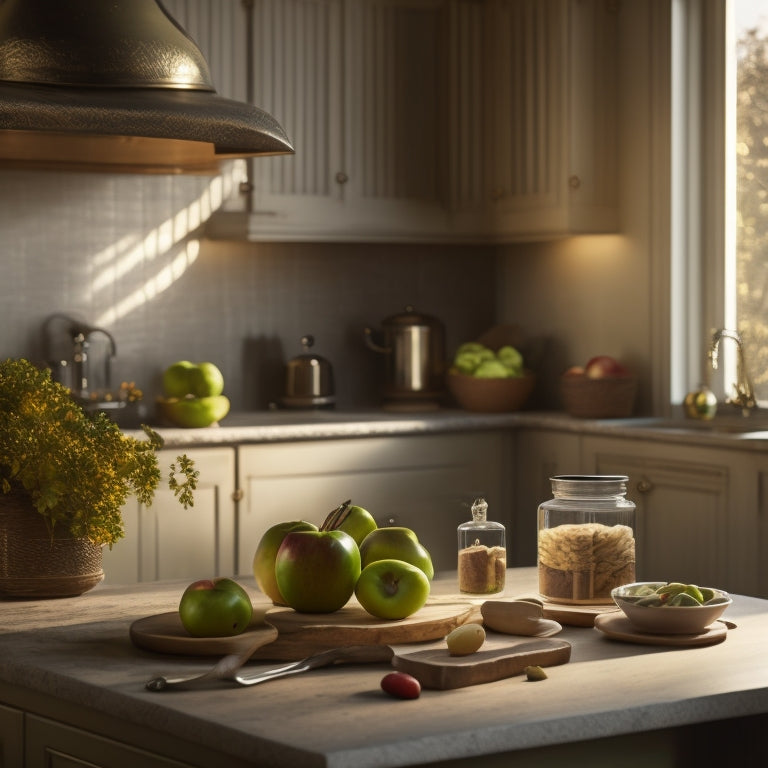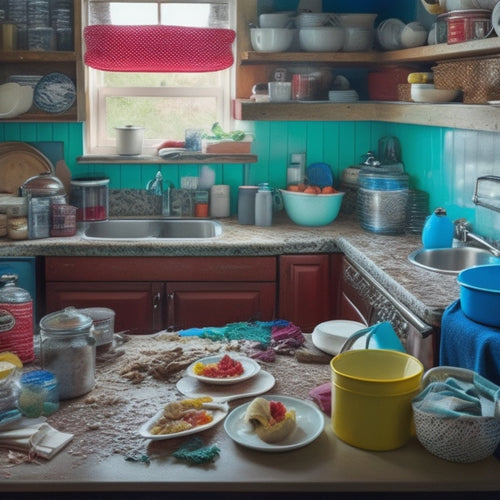
Conquer Kitchen Chaos With Expert Guidance
Share
You're tired of feeling overwhelmed by your cluttered kitchen. It's time to take control! Start by decluttering your countertops, sorting items into keep, donate/sell, and discard piles. Be ruthless - if you haven't used it in a month, it's likely taking up valuable space. Next, optimize your storage by implementing labeling systems, designing functional zones, and choosing container solutions that fit your needs. By streamlining your meal prep processes and developing time management strategies, you'll be on your way to a stress-free cooking experience. Now, get ready to reveal the secrets to a more efficient, organized kitchen.
Key Takeaways
• Tackle kitchen clutter by sorting items into keep, donate/sell, and discard piles, and be ruthless about unused items.
• Implement customized organization strategies, such as labeling systems and functional zones, to optimize storage and workflow.
• Maximize storage potential by utilizing adjustable shelves, baskets, and bins, and making use of often-wasted space above cabinets.
• Streamline meal prep processes by planning meals, grocery shopping, and prepping ingredients in advance to save time and reduce waste.
• Develop time management strategies to maintain organizational efforts and establish consistent routines to upkeep kitchen organization.
Decluttering Your Kitchen Space
Decluttering Your Kitchen Space
Start by tackling the countertops, where clutter tends to accumulate fastest, and sort items into three piles: keep, donate/sell, and discard.
Be ruthless – if you haven't used it in the past month, it's likely taking up valuable space.
Next, move on to your cabinets and pantry, removing expired or unnecessary items. As you declutter, consider an efficient layout that maximizes your kitchen's functionality.
Think about the 'golden triangle' concept, where your most frequently used items are within easy reach. Functional storage solutions, such as adjustable shelving and drawer dividers, can help maintain your newfound organization.
Remember, the goal is to create a space that works for you, not against you. By decluttering and optimizing your kitchen layout, you'll be able to cook, entertain, and live more efficiently.
You'll feel more in control, and your kitchen will become a haven of productivity and creativity.
Customized Organization Strategies
With your freshly decluttered kitchen space, you're now ready to implement customized organization strategies that cater to your unique cooking style and needs. This is where you get to create a system that works specifically for you, making cooking and meal prep a breeze.
To get started, consider the following essential components of customized organization:
| Strategy | Description | Benefits |
Labeling Systems
Assign names to containers and shelves
Easy identification, reduced search time
Functional Zones
Designate areas for specific tasks (e.g., baking, cooking)
Improved workflow, increased efficiency
Container Solutions
Choose containers that fit your needs and space
Optimized storage, reduced clutter
Maximizing Storage Potential
Now that you've customized your kitchen organization strategy, it's time to maximize your storage potential by making the most of every available space.
You've got a solid plan in place, but without efficient storage, your kitchen can quickly become cluttered again. Start by optimizing your pantry organization. Install adjustable shelves, baskets, and bins to store dry goods, snacks, and cooking supplies. Label each container so you can find what you need at a glance.
Next, assess your kitchen shelving. Consider installing floating shelves or a pegboard to hang frequently used items like pots, pans, and utensils. This will free up cabinet space for less frequently used items.
Don't forget to utilize the often-wasted space above your cabinets by adding decorative storage bins or baskets. By maximizing your storage potential, you'll be able to maintain your kitchen's organization and keep clutter at bay.
With a little creativity and planning, you can create a kitchen that's both functional and beautiful.
Streamlining Meal Prep Processes
Five key areas of meal prep can make all the difference in streamlining your process: planning, grocery shopping, food prep, cooking, and cleanup. By focusing on these areas, you'll be able to identify inefficiencies and implement time-saving techniques to get more done in less time.
Here are four essential strategies to help you streamline your meal prep process:
-
Meal planning:
Take some time to plan out your meals for the week, considering your dietary goals and ingredient availability. This will help you create a grocery list and avoid food waste. -
Batch cooking:
Cooking large batches of a single ingredient (like rice or chicken) can save you time during the week when preparing individual meals. -
Efficient tools:
Invest in tools like a slow cooker, Instant Pot, or food processor to simplify food prep and cooking tasks.
-
Prep in advance:
Set aside time to prep ingredients for upcoming meals, such as chopping vegetables or marinating meats. This will make cooking faster and more efficient.
Sustaining Organizational Habits
You've streamlined your meal prep process, but the next challenge is to maintain your new habits and keep your kitchen organized over time. It's essential to develop time management strategies to guarantee consistency in your organizational efforts.
Set aside a specific time each day or week to maintain your kitchen's organization, whether it's 10 minutes in the morning or an hour on the weekend. Consistency is key to developing habits that stick.
Create a routine that works for you, and stick to it. This could mean dedicating 30 minutes each evening to cleaning up after dinner or allocating an hour on Sundays to plan and prep meals for the week.
By incorporating time management and consistent routines into your daily life, you'll be able to sustain your organizational habits and keep your kitchen chaos-free. Remember, it's not about being perfect; it's about creating systems that work for you and your lifestyle.
With discipline and persistence, you'll be able to maintain your kitchen's organization and enjoy the benefits of a more efficient, stress-free cooking experience.
Frequently Asked Questions
How Do I Maintain Motivation to Organize My Kitchen Long-Term?
To maintain motivation, you'll create daily routines that become second nature, and make mindset shifts to view organization as a habit, not a chore, allowing you to stay focused and driven in your kitchen organization journey.
Can I Organize My Kitchen on a Very Tight Budget?
"You're not stuck between a rock and a hard place, and a organized kitchen is within reach! Get creative with DIY solutions and thrifty tips, like upcycled organization, to transform your space without breaking the bank."
How Do I Get My Family Members on Board With Kitchen Organization?
You'll get your family on board by explaining how kitchen organization benefits them, assigning tasks, and setting routines. Communicate the decluttering process, making it a team effort, and celebrate small wins to build motivation and maintain momentum.
What Are Some Eco-Friendly Kitchen Organization Products?
What's holding you back from a greener kitchen? You're likely seeking sustainable solutions! Opt for eco-friendly storage options like bamboo utensil holders, recycled glass containers, and compostable trash bags to create a more environmentally conscious kitchen space.
How Often Should I Reorganize and Reassess My Kitchen Space?
You should reorganize and reassess your kitchen space through seasonal decluttering and quarterly assessments, ensuring efficient storage and layout optimization to maintain a powerhouse kitchen that fuels your productivity and creativity.
Related Posts
-

What's Holding You Back From a Clutter-Free Kitchen?
You're struggling to achieve a clutter-free kitchen because one or more of eight common obstacles are standing in you...
